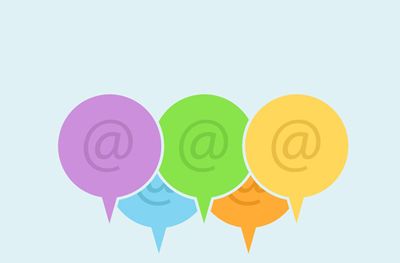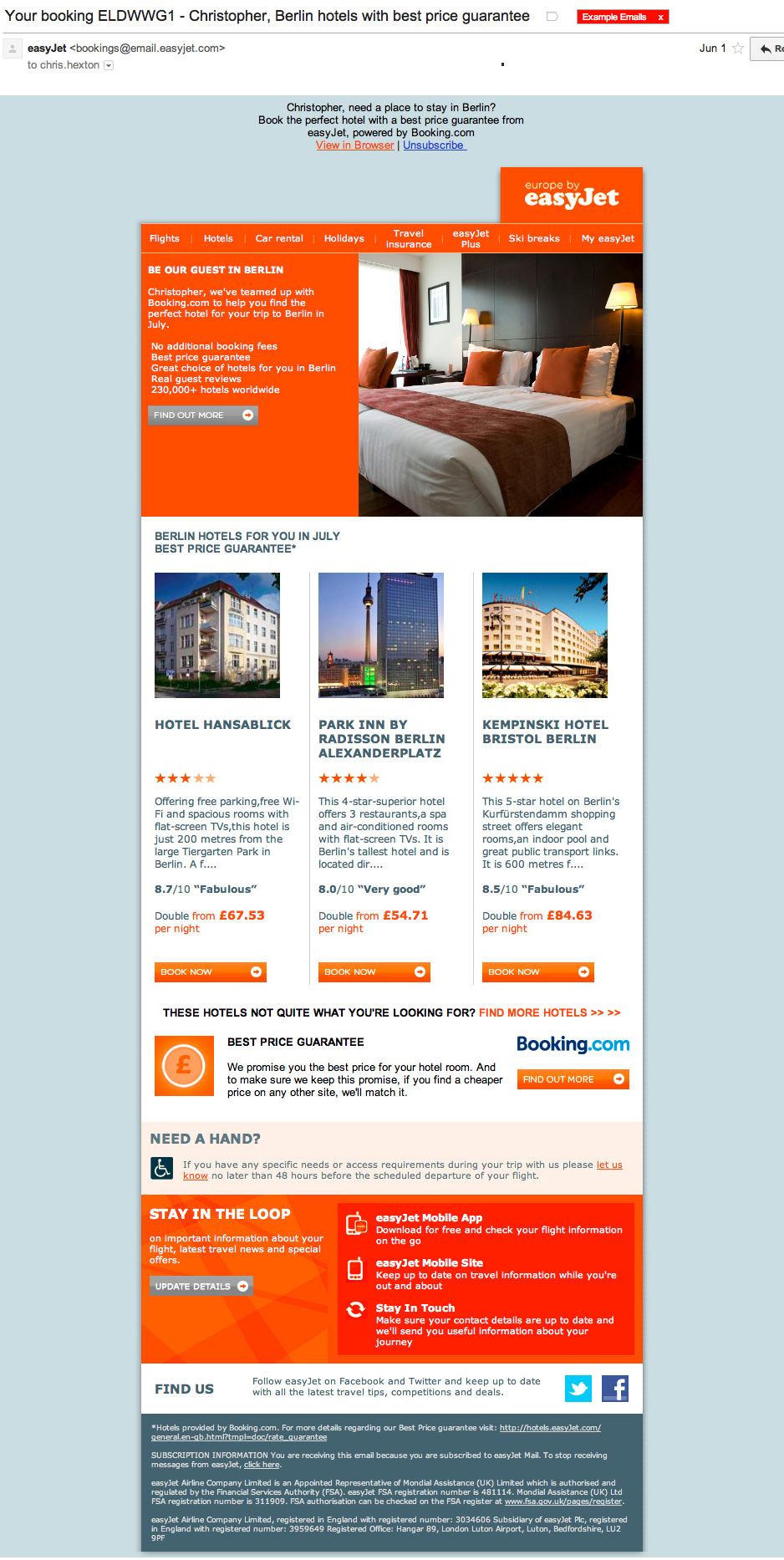
5 Conversion Optimization Pros Review A Triggered Email Campaign
-
Messaging and AutomationNews and UpdatesUpdatedPosted:
On this page
Getting your behavioural email marketing campaigns right is a process of trial and error. One of the great things about trigger-based email campaigns is that you can test and continually optimise them until they’re permanently increasing revenue for your business.
I got five of the best email marketing and conversion rate experts out there to review an email marketing campaign from easyJet.
Here’s the email:
An email like this is sent to customers after they book a flight with easyJet. The email is personalised based on the destination the customer is traveling to. I received this email myself a few months ago, so it’s extremely relevant.
This is an interesting email for three reasons:
- It’s triggered by user behavior. These sorts of campaigns aren’t discussed enough but drive a huge portion of email marketing conversions.
- There is a lot of personalised data. The email is populated with a ton of personalised data. This is usually something that can be done better.
- easyJet send a lot of email. Thanks to the nature of their business and the opportunities for cross-sells and up-sells, easyJet send a lot of emails. It’s always great to see what large companies with lot of resources are up to.
So, without further ado, here are the analyses from five top email and conversion experts on what this email does well and what they’d test to make it better.
 1. Jordie Van Rijn,
email marketing specialist
at Email Monday
1. Jordie Van Rijn,
email marketing specialist
at Email Monday
What’s good about this campaign?
- Referring to the customer’s individual booking in the subject line and including the booking number.Triggered transactional emails that are about something people bought consistently get high open rates. It might not be the best subject-line for this campaign but putting the booking number in there definitely seems like it’d be effective at getting opens.
- A triggered campaign based on needs: Everybody needs a place to stay while they are on travel. With this campaign, easyJet are playing on that need. A lot companies still don’t use triggered emails to upsell around purchases. I know easyJet actually send out a series of emails, highlighting other things like premium boarding, parking space at the airport and car rental – this email shows they do a good job.
- Partnering up: Even though easyJet don’t do hotel bookings themselves they teamed up with a partner to offer an additional service. Booking.com is a great match: they could even highlight this relationship more than they do in this campaign.
- Personalised, dynamic offers: The email is all about your specific destination (Berlin) which easyJet know through your booking. The offers are for double rooms, as you are travelling with two people. They are only showing hotels that aren’t fully booked yet. I’d bet they even use more intelligence on the back-end to align the offers to be the most likely ones you will buy. For instance sorting them by popularity, “most likely to appeal to couples” or “most likely to appeal to your customer profile”.
- They picked one selling point to highlight in the text: In this case the Best Price Guarantee. Seeing that easyJet is a low cost airline, price is definitely a logical starting point. It’s not always about a guarantee; “Best hotels, lowest price” might be a better way to propose the same and is much easier to understand.
- Use of reviews and star scoring: It is hard to make a choice if you don’t know the difference between options. Next to price they use stars to help highlight the difference between hotels, making it easier to determine which call to action you should take.
What would you test?
- The navigation bar at the top: I like an email with focus but, and this might be a surprise for most, the nav bar is definitely of influence when it comes to clicks. To get more focus on the deal, I’d swap Hotels to the left and remove a few of the options, such as “ski breaks”. I’d repeat this at the bottom, see which nav links get clicked on and lead to people buying and then change the options around some more. In all testing, but especially in email marketing, it is best to choose the winner based upon the impact on revenue: only use clicks and opens if you are not (yet) able to do that.
- Intro benefits text: The text starts with “We have…” – a big email marketing no-no! Make it about the benefits to the reader. Two of the five benefits in the intro aren’t really benefits. The number of hotels worldwide isn’t important if I’m going to Berlin and no additional booking fees makes you realise they exist in the first place. “Great choice of hotels in Berlin” is the most relevant part here, so I’d highlight that.Furthermore the colour of the intro is not ideal. White on orange is difficult to read. The button needs the highlighted contrast, not the block. Given that, I’d swap the colours: make the button orange and the background a lighter colour like white or light grey. The font could be bigger and obviously testing the button text makes sense. I’d try something like “See my Berlin offers”.
- Timing: In travel it is becoming much more common to first buy the ticket and later book a hotel. The timing is often best based on departure date and not, as you might think, on the date of purchase. The right timing depends on many factors, like the departure airport, buyer persona, when they did the booking, if it is in a weekend or not, etc, etc. So some complex testing is needed to get the timing right relative to the time the trip will be taken.
- Use of images: Images are very, very, very important in travel emails – almost as important as they are in fashion retail. But with all the hotels in their assortiment, there are a lot of images to test. A shortcut to getting more testing volume is to (also) test them on your website. Another way is to categorize the image types (exterior, interior room, one with a pool, city attractions, etc.), Find what works so you can repeat it in your emails.
- Landing pages for this campaign: The landing page related to a campaign is crucial to its success. After all, that is where people buy (or don’t)! If they go to Booking.com there should be a reference to easyJet, making sure that people know they landed on the right page. The pages where customers land from the offers and initial button should be tested: not just their design but also whether they should be taken to a product or a category page and how the hotel filtering might appear there.
 2. Tamara Gielen from
Plan to Engage
2. Tamara Gielen from
Plan to Engage
What’s good about this campaign?
- EasyJet nail two things here: relevancy and attracting the right audience for the offer by filtering out those people that have already booked a hotel.
- In terms of relevancy: given I’ve just booked a flight to Berlin, receiving this follow-up trying to up-sell makes sense – it’s extremely relevant to me as a traveller. They make this clear from the word go as the context is immediately visible in the subject line with the copy “Berlin hotels with best price guarantee”.
- In terms of attracting the right audience: the subject line here reveals the email is a direct commercial offer. This will help filter out those that have already booked a hotel and are therefore less inclined to open the email. This increases the conversion rate of customers that do engage with the email.
What would you test?
- I’d include a link in the pre-header text (up top where it says “Christopher, need a place to stay in Berlin?”). This can be a gold mine for clicks, so it’s a shame to miss out.
- The main introduction text in the orange section at the top – “Be Our Guest In Berlin” – doesn’t really stand out for me. I’d focus on a clearer title that is benefits-focused, maybe even the text from the pre-header. I’d include a couple of bullet points but nothing else. This section feels busy.
- I’d feature hotels in different price ranges or categories and list more of them. With this sort of campaign there is definitely room for more images and direct calls to action.
- All of the buttons appear to be images, I’d replace those with HTML buttons and test the button copy to increase click-throughs. Testing button copy is always a goldmine.
- Underneath each “Book Now” button I’d have a text link that says ”More X-star hotels”. This lets you distinguish between categories and directs different customers to different pages depending on what they’re looking for.
- The best price guarantee should be explained more prominently at the top of the email. Guarantees are a good kind of proof but there is no follow-up mention of it in this email: it just says “Best price guarantee”. Can I compare prices to any other site? How do I get the guarantee? Is this from Booking.com or easyJet? etc.
- With regards to the subject line, I would make sure to mention the booking details in the email again as well as people are expecting to see information about their booking. I think the subject line would generate a lot of opens but body content that doesn’t match the subject line at all rarely converts as well. As the details are not in the email itself, some recipients will feel tricked into opening the email expecting to see an update on their booking…and that is not a good user experience!
 3. Joanna Wiebe from
CopyHackers
3. Joanna Wiebe from
CopyHackers
What is good about this campaign?
- The subject line feels a little long to me, but there are two things I think it’s does well: a. It leverages the power of the confirmation number to get people to look and click, and b. It is personalized.
- When a sales email uses your name in the subject line, it often feels forced; when a triggered email (or what seems to successfully masquerade as one) uses your name, it’s appropriate because you have a relationship with that business and the campaign already.
- The treatment of the copy is great. The preheader text does more than just tell people to view the email in their browser; it reinforces the subject line and, for those people whose email client (e.g. Gmail) shows pre-header text after the subject line, this is bound to increase opens. Also, the body copy of the email is left-aligned and isn’t overlaid on any of the images. It’s safe to believe that the topmost/hero copy will be readable a) on mobile devices, b) in preview windows (e.g. in Outlook) that are right- or bottom-aligned and c) when images aren’t automatically downloaded.
What would you test?
- One of the biggest things that I don’t like here is the branding / positioning of the offer. If I was easyJet, I’d rename what they call their ‘best price hotel recommendations’ service; it should sound more like a concierge or white glove offering from easyJet. Something exclusive to easyJet. Something only easyJet customers get. As it stands, the offer reads very much like what it is: a partnership between easyJet and Booking.com to squeeze more money out of customers. Not optimal. Not exclusive. Repositioning this offer as a complimentary white-glove service would be soooo easy, I want to cry.
- The extra stuff at the bottom – everything below the 3 recommended hotels – is noise, and I’d cut it. easyJet should know, based on what info people entered when they bought their ticket, if the recipient has special needs that require assistance, and so they should only send emails about this to people who tick that box. For the mobile stuff they could drip out a mobile-optimized email that tells people on their mobile to ‘click here to get the app’ or ‘click here to bookmark the mobile site’ and why they should do both. An email with the subject line “We’ll text you travel details day-of – just tell us these 2 things” or something to that effect would get people who care about such a benefit to open their emails and actually do what you want them to; in this email it’s more likely this information just distracts people from the goal of booking a hotel.
- What does the mobile version look like? It doesn’t look very optimised and mobile is a huge component of opens these days.
- Can we get an email from a person, not “easyJet”? An easy one to miss, this speaks further to the type of branding easyJet could do for this service. If this email were from Susan at easyJet Concierge Services then I might actually believe this is coming from someone real. I’d test this designed email campaign against one where “Susan” from easyJet Concierge Service writes a personalized, low-design email to me with a congrats on my recently booked trip to Berlin, a few ideas where I might want to stay (including inline photos of those 3 hotels) and a request that I click a link to identify the attractions I’ll be visiting in Berlin so she or someone from their team can recommend even better hotels to me. The whole thing could be automated but, if done right, it would feel personal and exclusive to easyJet.
- “Find out more” is a lazy, high-friction call to action. No one wants to find out more. We want to “Save 18% on Berlin Hotels”, “Book a Room in a Top-Rated Berlin Hotel”, “Beat the Summer Rush – Book a Room Now”, “Search 19,000+ Berlin Rooms in 8 Seconds or Less” or “Tell Us What You Want, and We’ll Find You a Great Room”. Focus on the benefits!
- A link to Google maps could help me see where these hotels are in Berlin. It’s kinduv a big city: three randomly selected hotels are not going to scratch the surface of the average person’s needs.
- I’d love to see this without the images displayed. Images are becoming less of a problem for mobile device users, where images often display by default, but this email is clearly not optimized for mobile, so I don’t think we can excuse away the importance of making sure these images, when not displaying, leave only small empty boxes and use alt text that encourages people to click to display.
 4. Peep Laja from
ConversionXL
4. Peep Laja from
ConversionXL
What is good about this campaign?
- I really like this subject line with booking code. This is sure to get attention. Nicely done.
- The entire email is extremely specific. Not just random hotels but recommendations for a particular booking based on my individual itinerary and needs. There is always room for more but, you have to admit, this email is certainly targeted at a one-to-one level.
- It shows 3 examples for hotels you can get with ratings and prices. This sort of ‘digest’ approach works well here and having a variety of hotels (based on price and rating) is better than just mentioning one sort.
- Given the digest nature of the campaign it’s good to see plenty of calls to action to get you to click through.
What would you test?
- The email starts off boring and vague: there is too much space is wasted up top. I would make the intro text more concise. I’d cut half the text and white space in the top half of this email. You know it’s goal from the subject line: get into it.
- “Find out more” is a poor call to action: I have no idea at all what is waiting for me after I click. This has to be much more specific. An example that comes to mind is “See Berlin hotels available between 4-9 July”.
- I would test adding calls to actions for hotel preferences: “Choose the type of hotels you want to see: [Downtown] [Budget] [Luxury]” and so on. This would add to the personal approach and gives another direction for people to go: taking them to a landing page where the hotels are filtered appropriately.
- Consider changing the “Book now” copy on the hotel calls to action to something like “See hotel”. I think “Book Now” is a bit premature: many recipients would not be ready to buy in an email just yet.
- I would mention why am I shown these 3 hotels in particular. Maybe mention that one is “most popular”, one has “best reviews” and one is “best deal”. This creates context I can believe in. Right now it feels a bit random, despite the hotels being targeted on Berlin.
 5. Aaron Agius from
LouderOnline
5. Aaron Agius from
LouderOnline
What is good about this campaign?
- One of the things that I really like about this campaign is that they have partnered with Booking.com to leverage credibility and create an up-sell opportunity that they would not otherwise have had. Not only does partnering with a company as well-known add social proof but gives easyJet an amazing inventory to play with and optimise.
- The nature of this campaign lends itself to a having a series of calls to action. I think that including a range of hotels offered, from low-end to 5-star, is a smart move and speaks to a lot of different recipients.
What would you test?
- Email subject: I’m not convinced that including the reference number is the best way to get conversions out of this campaign. There is no doubt that it is going to get recipients’ attention but it seems misleading and there is no clear call to action in the subject itself. This leads to incongruence and that can be a killer for email conversions!
- Too many options and way too much content: the content at the top and the bottom feels distracting. It’s not relevant and takes away from the primary call to action: to get you to view and book a hotel! I’d pretty much cut-off the email at the ‘Need a hand’ section down. The top half would suffice and, I’d imagine, removing the excess would dramatically increase conversions.
- I think the options in the main navigation bar could be better presented elsewhere or even left out in some cases. The goal of the email is clear and, although nav bars can be effective, I’d definitely want to test the results of removing this one. It’d be possible to see the effects this has on direct conversions vs. how much incremental revenue is being driven by that nav bar.
- Sender Name: this email could definitely come from an individual. I’d imagine that’d see higher open rates, regardless of the rest of the subject line. This is a no brainer!
What would you test?
So – there you have it. There are some great ideas in here you can use for any email marketing campaign and the through-processes used by the experts are absolute gold.
What would you test about this campaign? Leave an idea in the comments!
If you haven’t A/B tested one of your campaigns recently, now’s a great time to do it. If you’re looking to A/B test an automated or series campaign then you should check out Vero’s free trial (to see it in action). Powerful stuff.



